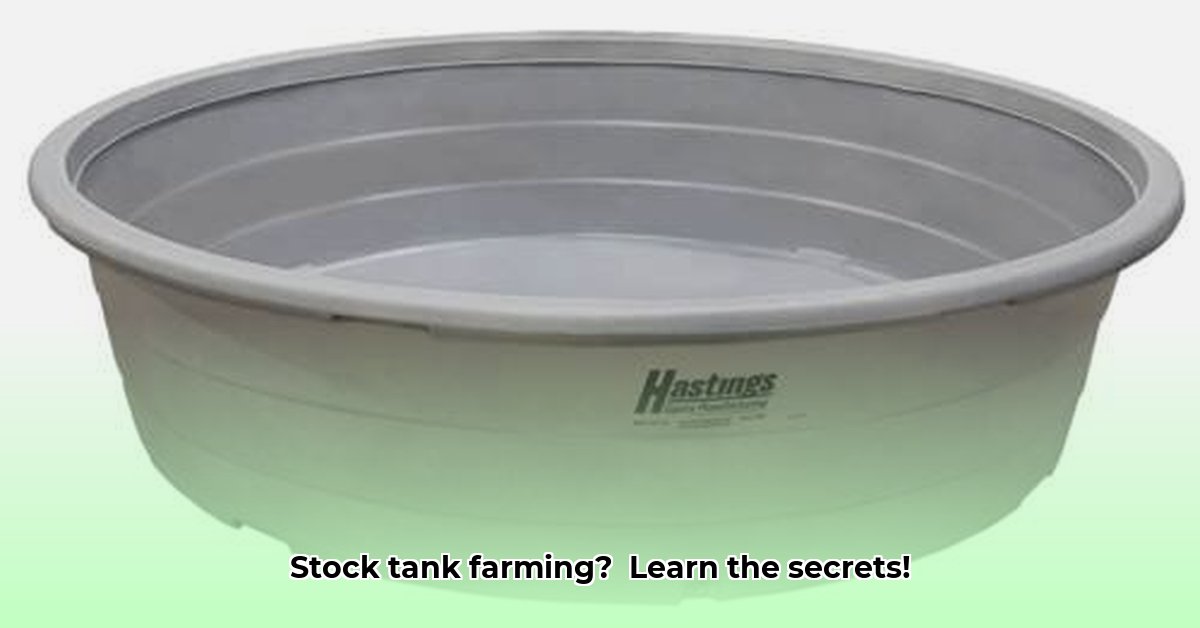
Thinking about enhancing your farm's sustainability? A 12-foot stock tank from Tractor Supply could be your solution. This comprehensive guide provides a step-by-step approach to selecting, installing, and maintaining a stock tank for various sustainable agricultural applications. We'll explore the key factors influencing your decision, ensuring a successful and impactful addition to your farm. For more sustainable farming resources, check out this helpful site.
Choosing Your 12-Foot Stock Tank: Poly vs. Steel
The first crucial decision is the material: polyethylene (poly) or steel? Both are readily available, each with distinct advantages and disadvantages. Poly tanks offer a lower initial cost and lighter weight, simplifying transportation and installation. However, they are less durable and more susceptible to UV degradation and damage from harsh weather conditions, potentially leading to shorter lifespans and increased repair costs over time.
Steel tanks, while pricier upfront, boast superior strength and longevity. These tanks are more resistant to impacts and extreme weather conditions, making them a worthwhile investment for long-term use. However, they require more robust handling during installation and are heavier, requiring appropriate lifting mechanisms.
To assist in your decision, consider this comparison:
| Feature | Poly Tank | Steel Tank |
|---|---|---|
| Durability | Moderate; prone to UV degradation | High; more resistant to impact and weather |
| Weight | Lighter; easier to transport and handle | Heavier; requires more robust handling |
| Initial Cost | Lower | Higher |
| Long-term Cost | Potentially higher due to repairs | Typically lower repair costs over time |
| Environmental Impact | Production and disposal considerations | Production and disposal considerations |
The environmental impact of both materials is a factor worthy of consideration. While both have environmental footprints associated with their production and eventual disposal, research into more sustainable manufacturing is ongoing for both poly and steel tanks. Stay informed about these advancements as technology evolves. Isn't minimizing your environmental impact a key objective in sustainable farming?
Planning Your 12-Foot Stock Tank Installation: A Step-by-Step Guide
Installing a 12-foot stock tank requires careful planning to ensure a smooth and successful outcome. Following these steps will minimize potential complications and maximize the tank's longevity.
1. Site Preparation: Laying the Foundation. Begin by selecting a level location with easy access for filling, cleaning, and maintenance. For "bottomless" tanks (tanks without a base), a solid concrete base is essential to prevent settling and potential leaks. Thoroughly level and compact the ground before pouring the concrete. This crucial step ensures stability and prevents costly future problems. Proper site prep significantly impacts the tank's longevity.
2. Delivery Day: Efficient Tank Transport. Remember, these tanks are substantial. When ordering, confirm with Tractor Supply that liftgate service is included in your order to ensure safe unloading from the delivery truck. The alternative requires heavy lifting equipment and can unnecessarily increase your costs.
3. Positioning and Installation: Accurate Placement. Carefully position the tank on the prepared base (or concrete slab for bottomless tanks), ensuring even weight distribution. Your choice of poly versus steel will significantly impact this step and the required tools or assistance. Consult the tank's instructions for specific guidance.
4. Post-Installation Inspection: Leak Detection. Following installation, thoroughly inspect the tank for any leaks or damage. Addressing minor issues immediately prevents more substantial repairs later. Taking this extra step significantly increases the lifespan of your investment.
Sustainable Applications: Beyond Livestock Watering
The versatility of a 12-foot stock tank extends beyond livestock watering. Its large capacity opens possibilities for various sustainable practices:
- Rainwater Harvesting: Collect rainwater for irrigation, reducing your dependence on municipal water sources. This conserves water resources and reduces your operating costs.
- Livestock Watering: Provide ample and reliable water for your animals, essential for their health and productivity. Adequate water access is crucial for any agricultural operation.
- Fish Farming: Create a small-scale aquaculture system for sustainable food production.
- Emergency Water Storage: Maintain a readily available water reserve in case of drought or other emergencies. Isn't ensuring water security a priority for every farm?
- Irrigation: Use the tank as a central reservoir for your irrigation system.
Maintenance and Longevity: Extending Your Tank's Lifespan
Regular maintenance is key to maximizing your tank’s lifespan and preventing costly repairs.
- Cleaning: Periodically clean the tank to prevent algae growth and maintain water quality. The frequency depends on the climate and tank use. Regular cleaning is critical for hygiene and water purity.
- Inspection: Regularly inspect for cracks, damage, or leaks. Addressing minor issues promptly prevents larger problems.
- Repair: Learn basic repair techniques to address minor issues efficiently. Proactive maintenance extends the lifespan of your investment.
A well-maintained 12-foot stock tank from Tractor Supply is a valuable, long-term asset for sustainable farming practices. By carefully considering material selection, planning installation, and implementing a regular maintenance routine, you can effectively maximize its contribution to your sustainable farming goals.